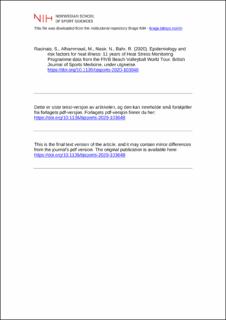| dc.contributor.author | Racinais, Sebastien | |
| dc.contributor.author | Alhammoud, Marine | |
| dc.contributor.author | Nasir, Nada | |
| dc.contributor.author | Bahr, Roald | |
| dc.date.accessioned | 2021-02-10T07:43:23Z | |
| dc.date.available | 2021-02-10T07:43:23Z | |
| dc.date.created | 2020-12-07T11:05:47Z | |
| dc.date.issued | 2020 | |
| dc.identifier.citation | British Journal of Sports Medicine. 2020, . | en_US |
| dc.identifier.issn | 0306-3674 | |
| dc.identifier.uri | https://hdl.handle.net/11250/2727040 | |
| dc.description | I Brage finner du siste tekst-versjon av artikkelen, og den kan inneholde ubetydelige forskjeller fra forlagets pdf-versjon. Forlagets pdf-versjon finner du på bjsm.bmj.com / In Brage you'll find the final text version of the article, and it may contain insignificant differences from the journal's pdf version. The definitive version is available at bjsm.bmj.com | en_US |
| dc.description.abstract | Objectives: To analyse 11 years of FIVB heat stress-monitoring data to determine the relative influence of the different environmental parameters in increasing the likelihood of a heat-related medical time-out (MTOheat). Methods: A total of 8530 matches were recorded. The referee measured air temperature, black globe temperature, relative humidity and wet-bulb globe temperature (WBGT) before the matches, and registered the MTOheat. The absolute humidity was computed at posteriori. Results: There were 20 MTOheat cases, but only 3 resulted in forfeiting the match. MTOheat incidence was not statistically impacted by sex (p=0.59). MTOheat cases were more prevalent during the games played in Asia during the 4th quarter of the year (p<0.001). Two cases of MTOheat experienced diarrhoea or gastroenteritis during the 5 preceding days; both of them forfeited the match. A principal component analysis showed a specific environmental profile for the matches with MTOheat. They occurred at higher WBGT, temperatures and absolute humidity (p<0.001), but with a lower relative humidity (p=0.027). Conclusions: The current data showed that an increase in ambient or black globe temperature, but not relative humidity, increased the risk of a MTOheat; but that the absolute risk remained low in elite beach volleyball players. However, suffering or recovering from a recent illness may represent a risk factor for a MTOheat to lead to player forfeit. | en_US |
| dc.language.iso | eng | en_US |
| dc.subject | elite performance | en_US |
| dc.subject | exertional heat stress | en_US |
| dc.subject | heat acclimatisation | en_US |
| dc.subject | thermoregulation | en_US |
| dc.subject | volleyball | en_US |
| dc.title | Epidemiology and risk factors for heat illness: 11 years of Heat Stress Monitoring Programme data from the FIVB Beach Volleyball World Tour | en_US |
| dc.type | Peer reviewed | en_US |
| dc.type | Journal article | en_US |
| dc.description.version | acceptedVersion | en_US |
| dc.source.pagenumber | 6 | en_US |
| dc.source.journal | British Journal of Sports Medicine. 2020, under utgivelse. | en_US |
| dc.identifier.doi | 10.1136/bjsports-2020-103048 | |
| dc.identifier.cristin | 1856812 | |
| dc.description.localcode | Institutt for idrettsmedisinske fag / Department of Sports Medicine | en_US |
| cristin.ispublished | true | |
| cristin.fulltext | postprint | |
| cristin.qualitycode | 2 | |
